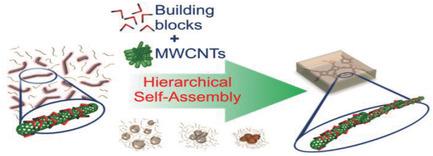当前位置:
X-MOL 学术
›
Adv. Mater. Interfaces
›
论文详情
Our official English website, www.x-mol.net, welcomes your feedback! (Note: you will need to create a separate account there.)
Enhanced Conductivity for Carbon Nanotube Based Materials through Supramolecular Hierarchical Self‐Assembly
Advanced Materials Interfaces ( IF 5.4 ) Pub Date : 2018-02-26 , DOI: 10.1002/admi.201701585 Gustavo A. Zelada-Guillén 1, 2 , Martha V. Escárcega-Bobadilla 1, 3 , Marcin Wegrzyn 4 , Enrique Giménez 5 , Gerhard Maier 2 , Arjan W. Kleij 3, 6
Advanced Materials Interfaces ( IF 5.4 ) Pub Date : 2018-02-26 , DOI: 10.1002/admi.201701585 Gustavo A. Zelada-Guillén 1, 2 , Martha V. Escárcega-Bobadilla 1, 3 , Marcin Wegrzyn 4 , Enrique Giménez 5 , Gerhard Maier 2 , Arjan W. Kleij 3, 6
Affiliation

|
The currently limited comprehension of hierarchical control over out‐of‐equilibrium (dynamic) self‐assembly processes in nanoscience and nanotechnology has limited the exploitation of multicomponent systems in the design of new nanostructured functional materials. In this study's contribution, molecular building blocks with tailored nanoscale anisotropic supramolecular self‐assembly behavior enable the creation of mesoscale percolation networks of multiwalled carbon nanotubes through collinear interconnections at the microscale. This strategy affords polymeric composites with tunable properties at the macroscale, where the organization mechanism is regulated by dynamic self‐assembly at 4 hierarchical levels of auto‐organization. Such multilevel self‐assembly system reduces up to eightfolds the nanotube concentration required for percolation and enhances conductivity up to 6 orders of magnitude against blanks, thus yielding anisotropically semiconducting and conducting materials. The approach is based on casting‐from‐solution, thus simplifying preparative steps when compared to state‐of‐the‐art electron carrier counterparts such as single‐walled carbon nanotube‐, graphene‐, or indium‐tin‐oxide‐based technologies. Finally, promising material transparency levels can be reached across the visible and near‐infrared regimes for compositions above the percolation threshold, which provides new opportunities beyond the current spectral restrictions in commercial transparent conductors.
中文翻译:

通过超分子分层自组装增强碳纳米管基材料的电导率
当前对纳米科学和纳米技术中失衡(动态)自组装过程的分级控制的理解有限,这限制了在设计新型纳米结构功能材料时对多组分系统的利用。在这项研究的贡献中,具有量身定制的纳米级各向异性超分子自组装行为的分子构建基块通过微观尺度上的共线互连,能够创建多壁碳纳米管的中尺度渗滤网络。这种策略使聚合物复合材料在宏观上具有可调的特性,其中组织机制由动态自组装在自动组织的4个层次级别上进行调节。这种多级自组装系统可将渗滤所需的纳米管浓度降低多达八倍,并且相对于坯料可将导电率提高多达6个数量级,从而产生各向异性的半导体和导电材料。与基于单壁碳纳米管,石墨烯或铟锡氧化物的先进电子载流子相比,该方法基于从溶液浇铸的方法,从而简化了制备步骤。最后,对于超过渗滤阈值的成分,可以在可见光和近红外范围内达到令人满意的材料透明度水平,这为目前商业透明导体的光谱限制提供了新的机遇。因此产生各向异性的半导体和导电材料。与基于单壁碳纳米管,石墨烯或铟锡氧化物的先进电子载体相比,该方法基于从溶液浇铸的方法,从而简化了制备步骤。最后,对于超过渗滤阈值的成分,可以在可见光和近红外范围内达到令人满意的材料透明度水平,这为目前商业透明导体的光谱限制提供了新的机遇。因此产生各向异性的半导体和导电材料。与基于单壁碳纳米管,石墨烯或铟锡氧化物的先进电子载体相比,该方法基于从溶液浇铸的方法,从而简化了制备步骤。最后,对于超过渗滤阈值的成分,可以在可见光和近红外范围内达到令人满意的材料透明度水平,这为目前商业透明导体的光谱限制提供了新的机遇。
更新日期:2018-02-26
中文翻译:

通过超分子分层自组装增强碳纳米管基材料的电导率
当前对纳米科学和纳米技术中失衡(动态)自组装过程的分级控制的理解有限,这限制了在设计新型纳米结构功能材料时对多组分系统的利用。在这项研究的贡献中,具有量身定制的纳米级各向异性超分子自组装行为的分子构建基块通过微观尺度上的共线互连,能够创建多壁碳纳米管的中尺度渗滤网络。这种策略使聚合物复合材料在宏观上具有可调的特性,其中组织机制由动态自组装在自动组织的4个层次级别上进行调节。这种多级自组装系统可将渗滤所需的纳米管浓度降低多达八倍,并且相对于坯料可将导电率提高多达6个数量级,从而产生各向异性的半导体和导电材料。与基于单壁碳纳米管,石墨烯或铟锡氧化物的先进电子载流子相比,该方法基于从溶液浇铸的方法,从而简化了制备步骤。最后,对于超过渗滤阈值的成分,可以在可见光和近红外范围内达到令人满意的材料透明度水平,这为目前商业透明导体的光谱限制提供了新的机遇。因此产生各向异性的半导体和导电材料。与基于单壁碳纳米管,石墨烯或铟锡氧化物的先进电子载体相比,该方法基于从溶液浇铸的方法,从而简化了制备步骤。最后,对于超过渗滤阈值的成分,可以在可见光和近红外范围内达到令人满意的材料透明度水平,这为目前商业透明导体的光谱限制提供了新的机遇。因此产生各向异性的半导体和导电材料。与基于单壁碳纳米管,石墨烯或铟锡氧化物的先进电子载体相比,该方法基于从溶液浇铸的方法,从而简化了制备步骤。最后,对于超过渗滤阈值的成分,可以在可见光和近红外范围内达到令人满意的材料透明度水平,这为目前商业透明导体的光谱限制提供了新的机遇。


























 京公网安备 11010802027423号
京公网安备 11010802027423号